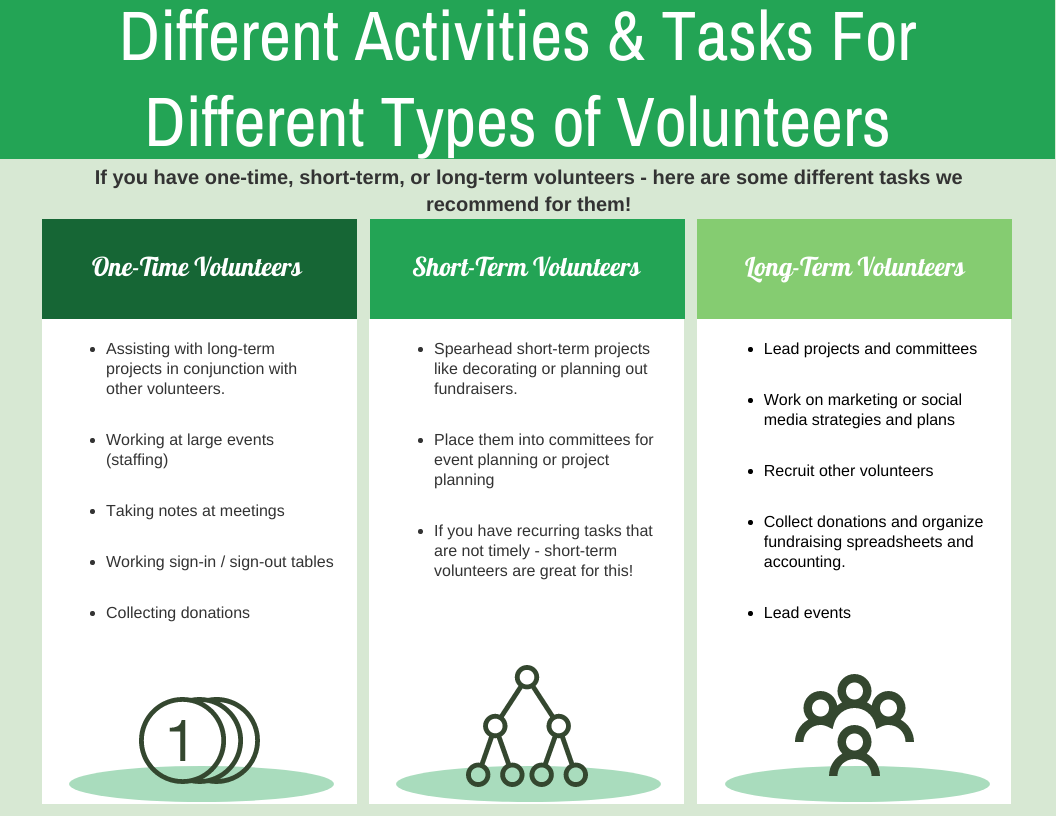One of the best ways to have a great volunteer program is to have long-term volunteers who are very committed to the cause and to helping you as a Volunteer Coordinator.
Long-term volunteers are easily retainable and are a great asset to rely on for your volunteer program to continue thriving. If your organization relies on volunteers heavily and can showcase large volunteer impact - long-term volunteers are the answer.
Check out this article to see the pros and cons of short-term volunteers and long-term volunteers.
Short-term volunteers Vs. Long-term volunteers

Short-term volunteers are volunteers that are not quite regular volunteers, but they show up more than once to help. Because of this, short-term volunteers are usually given shorter tasks, or tasks that take less time to complete because they are only around for short periods of time, or irregularly.
Not to be confused with one-time volunteers. One-time volunteers are exactly what it sounds like - they only volunteer once or once in a blue moon. These volunteers might be busy and don’t priorize volunteering, so they aren’t as reliable as short-term volunteers - but definitely still appreciated!
Long-term volunteers are volunteers who are regular, you see them often, and they commit a good amount of time to your volunteer program. Long-term volunteers can be given tasks that take a long time to complete because they will be back for multiple months and sessions to complete them. They can also be given tasks that are a bit more meaningful and sensitive. Due to their immense amount of volunteer time, long-term volunteers can earn trust to be given sensitive information and complete more administrative tasks - if needed!
Sometimes, a volunteer program might not want a lot of long-term volunteers or volunteers completing case-sensitive tasks - and that’s fine! Determine which type of volunteers will best suit your organization, and then follow the steps below to attempt to convert all of your volunteers into that type of volunteer!
7 Steps to Convert Short-Term Volunteers Into Long-Term Volunteers
Or Convert One-Time Volunteers to Short-Term Volunteers!
Follow these steps to lead your volunteers (that want to) into becoming a long-term volunteer for your organization!
1. Separate Your Short-Term From Long-Term Volunteers
It is good to distinguish between long-term volunteers and short-term volunteers in any sort of volunteer software that you have. This is good not only for records, but in any sort of communication.
You should have different communication with long-term volunteers and short-term volunteers. With long-term volunteers you can talk about more behind the scenes volunteering. Where short-term volunteers are going to be signing up for shifts and events.
You can separate your long-term volunteers and short-term volunteers in a volunteer software system like Track It Forward by customizing their online profile that they log hours and sign up for events with.
2. Introduce Them To Long-Term Volunteers
Next, you might want to recruit a friendly long-term volunteer to be sort of an “ambassador” for short-term volunteers. This long-term volunteer will introduce the short-term volunteers to more tasks and more efforts done by the volunteers.
This is a great way for the short-term volunteers to see what type of work they might be able to get involved in, if they are interested, and it will allow them to feel comfortable with the existing long-term volunteerbase.
3. Invite Them To Long-Term Volunteer Activities
In conjunction with attempting to make short-term volunteers comfortable in a long-term volunteer setting - bring them to long-term volunteer activities.
Long-term volunteers usually have a bigger role in a volunteer program, and this allows them to easily see their impact on the organization. If short-term volunteers see this, they might be more motivated to volunteer more!
In addition, short-term volunteers will feel more accepted and comfortable with the long-term volunteers. If you have a volunteer that participates in activities for a social aspect, this step will appeal to them!
4. Create A Transitional Contact Method
If you adopt having two separate contact methods for short-term volunteers and long-term volunteers - this step is important. You’ll want to create a contact process that can transition short-term volunteers into the long-term volunteer contact list.
This might include sending a few emails including both short-term and long-term volunteer initiatives or even contacting them and asking them more about what motivates them to volunteer.
This is a great starting point to figure out exactly what type of volunteer this potential new long-term volunteer might be!
5. Ask Them What Activites They Would Like To Get Into
Long-term volunteers have a bigger choice in what activities they will be doing than most one-time or short-term volunteers. It is important to incorporate this level of freedom as an incentive to become a long-term volunteer.
If the volunteer is eager to do more, they will usually respond with more details than leaving them out. This is a great way to know for certain that they would like to volunteer more and transition from a short-term volunteer to a long-term volunteer.
Remember - not everyone can be a long-term volunteer. It is important in this step to respect the wishes of volunteers if they would like to be a lower-committed volunteer. You don’t want your volunteers to feel forced to be a long-term volunteer, or they might back out in total!
6. Obtain A Schedule For Their Availability
When the short-term volunteer decides that they might want to volunteer more - ask them if this means on a regular basis! If so, you can definitely ask for availability and start scheduling the volunteer on a regular basis.
This is a great way to transition a short-term volunteer into a long-term volunteer. You will be counting on them regularly, instead of waiting for them to sign up to volunteer!
7. Ask If They Are Interested In Commiting More Time & Becoming More Involved!
Make it official! Validate their time and commitment by asking them if they would like to be an official long-term volunteer.
You can create a program for your long-term volunteers to be ambassadors for certain programs, committee heads, or even have special perks like free coffee for long-term volunteers! This will help short-term volunteers know they are makign a positive decision!
Every volunteer program is different, so the steps might alter and should definitely be more detailed when it comes to your volunteer program. Just note that natural progressions like this one are usually more successful long-term when it comes to converting short-term volunteers!
 Written by
Written by